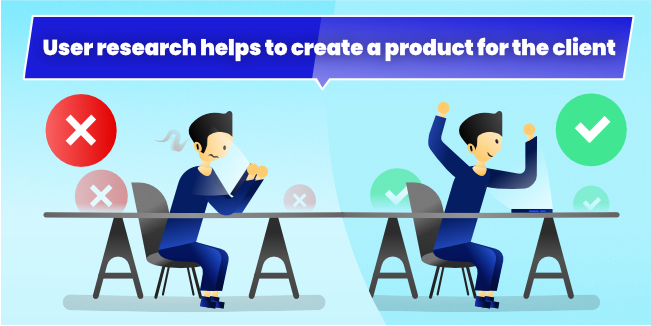productdiscovery
userresearch
userstudies
User Research - what is it, and why should you do it?

In this article, we'll look at user research and how it's typically employed, as well as some of the best practices in user research activities. That guide to UX research approaches (including mental models, behavioral research, and user interviews) will help you develop a successful UX design from the start.
What is User Research?
User research is all about understanding what people think, feel, and do in relation to your product. It's essential for creating effective products that solve real problems. User researchers can discover insights that designers and engineers can't "design" or "engineer" themselves because they're not the ones using the product every day.
User research is a systematic study of target users, including their needs and pain spots, for designers to have the sharpest possible insights to create the greatest designs. User researchers employ a variety of approaches to identify issues and develop possibilities while also obtaining vital information that they can utilize in their design process.
User research vs. usability studies
We often get asked how user research differs from a usability study. Well, it depends on who you ask! Companies have traditionally used usability testing to compare multiple designs to find out which one performs better with users. But today, design teams are putting more value in conducting user research—so much so that some consider this expression outdated. A newer term gaining currency in the design community is user studies.

Usability testing is one of many standard tools used in user research (alongside contextual inquiry, personas, card sorting, etc.). User research includes various methods that investigate user behavior, motivation, needs, and emotions to inform the design process. This data is then used to generate different perspectives on product designs, tested with users before implementation.
The goal remains essentially the same: to obtain feedback on designs with or without testing them against competitors'. But instead of testing "Which design looks better?" designers now ask broader questions like "What's most important to our users? How do they feel about this part of our product? What would make them keep using it?"
These changes in perspective have resulted in a new generation of tools and techniques teams can use to understand users better, and test app ideas as much as possible. Some, like low-fidelity prototyping, are now household names. Others, like usability testing, remain as relevant as ever.
Usability testing has always been one of the significant pillars of user research: it's one of the first things that come to mind when you think about it. It was originally used as a tool for refining product concepts. Still, it quickly evolved into something more general: a means for getting feedback on your designs before actually building them.
This approach is now often known as formative research. The term "research" here doesn't mean fancy theory or "sciency" methods – it simply refers to gathering information. In this case, we want information about our users and tasks to make informed decisions throughout the design process.
Qualitative vs. Quantitative Data: What’s The Difference?
It may appear to be a no-brainer to label user research as an essential component of any interaction design process. It's the only approach to figure out precisely what these people want, first determining who they are. To go about collecting this information, you must use a method that is structured.

User research may be used at any stage during the design process. First, you must pick appropriate methods for your study's aim and produce the most accurate information. After that, to obtain the insights you desire, you'll need to interpret all of your findings from all of that data, which might be challenging. Researchers generally start with qualitative assessments to discover users' needs and intentions. They could subsequently validate their findings using quantitative measures if their results were correct.
Qualitative research
Qualitative research needs a lot of attention. Methods like ethnographic field research and interviews can be useful in gaining a thorough knowledge of why people act the way they do (e.g., why they abandon a website as fast). By asking open-ended questions, you may obtain sharp insights into customers' purchasing behaviors by, for example, interviewing a small sample of individuals. Usability testing is another aspect of this kind of study. Because it involves gathering non-numeric data (i.e., opinions), your viewpoints might impact the results.
Quantitative research
Quantitative data alone cannot provide deeper insights into human behavior. Surveys, for example, provide more structured ways to collect data on what customers do and test assumptions derived from qualitative research. An online survey, for example, may be used to ask users about their shopping habits. You may discover regularities in a large user group by utilizing this data. The larger the sample of representative test users you have, the more likely you will have a statistically valid method for assessing the target user population. Regardless of the approach used, you can obtain objective and impartial information with good research.
Attitudinal research, also known as attitudinal, focuses on what users say (during interviews). Observational techniques are used to observe their behaviors. Typically, when you combine both quantitative and qualitative research, as well as a combination of attitudinal and behavioral approaches, you'll get the clearest picture of an issue.
What Is The Purpose Of User Research?
User research aims to collect information about how people attempt to complete a task or achieve a goal. It might simply be watching them use your app on their own, or it may be as time-consuming as interviewing compensated users for an hour-long interview about their prior experiences with similar apps/systems/products.
User research is the process of putting your design project in context. It aids you in comprehending the issue you're trying to address, who your users are, where they'll use your product or service, and what they want from you, the designer!
Your User Experience design research is one of the most critical aspects of your product design. It's critical to consider the user throughout the design process to develop a successful product. Your UX research will help you in many ways throughout the design process. It'll assist you in identifying issues, challenges, and assumptions that need validation, identify patterns and commonalities across your target user groups and shed light on your users' needs and goals.

Why is this so significant? You're essentially speculating without UX research. It's near-impossible to know what needs and pain points your design should target if you don't speak with real users. Conducting user research is important because user research helps you create a better application/system! You can listen to user feedback and find user needs. Thanks to that, you can accomplish every design process with your users!
There's a myth that you can do some preliminary research and testing at the end of your project. You must first conduct user experience research, perform usability testing, and iterate based on the findings. It is because UX research improves the design. The goal is to create goods and services that consumers would utilize.
User research is always kept at the heart of your design process. User research is frequently neglected as a time-consuming or unimportant step in the process—but it's crucial from both a design and a business standpoint.
Suppose you (or your client) choose to skip the research phase. In that case, there's a good chance you'll wind up spending time and money creating something that has lots of usability issues and design flaws or isn't necessary. Early detection of these problems may save you time, money, and frustration! The time and money spared by not conducting user research far outweigh the potential risks!
The research stage guarantees that your ideas are based on real knowledge and data. Consider a product you're planning to release that has the potential to fill a need in the market but is plagued with bugs and usability problems because of a lack of user testing.
The value-action gap is a well-known psychological principle that explains how people do not follow through on what they promise. Both qualitative and quantitative data are useful in user research. To avoid running into the value-action gap, which can sometimes make qualitative data unreliable, it's a good idea to have a blend of both types of information at hand.
Planning your user research requires more than just doing User Focus Groups—observing your users is crucial. It would help if you watched what your users do. A great user researcher is an expert at formulating relevant questions and receiving impartial answers from your customers. To do so, we must consider ourselves as the user. Put yourself in your user's shoes without your preconceptions and beliefs on how it should function and what it should be.

The Nielsen Norman Group, an industry-leading user experience consultancy, identifies the best user research techniques for your project's four phases. Here are some of the most common strategies and procedures to utilize.
Discover: We start by exploring what's relevant for the people who will use our product or service.
The following components of a user-focused design research framework can be included in diary studies. Users may keep track of their performance in activities or recall their daily interactions with a design. The second component is contextual questions, interviews with qualified people in their natural environment to find out how they do the tasks.
Explore: how to meet the needs of all users?
You should sort your information into categories. On cards, write words and phrases or names of products or people, then allow customers to arrange them in the most useful arrangement while labeling categories to ensure that your layout is logically organized. Make a user journey map to identify potential issues and key pain points.
Test: Evaluate your designs and make changes if required.
Make sure that your design is simple to use through usability testing. Test your design to see if it's accessible and understandable to everyone.
Listen: Take a step back and think about issues in light of everything else. Any new problems, as well as patterns and trends, should be discovered.
To cover that stage, you'll need analytics. You may collect data and all relevant metrics for your app with them, such as traffic or conversions. Analyze the pages that are influencing your revenue and improve them. Make use of questionnaires to determine how customers feel about your product.
Before you conduct user research, consider the advantages and drawbacks of each method. Card sorting is quick and simple, but it might take a long time to analyze further. Furthermore, it might not provide contextual significance in depth. Another constraint to bear in mind is your budget. These will determine when, how much, and what sort of user research you can accomplish. As a result, only the most important approach/s should be selected for your research. Also, get company stakeholders involved early on in the process. They may provide helpful information and aid you keep your study on track regarding corporate objectives. Overall, user research is an efficient method of validating design assumptions about users in the field while also reducing expenditure on the finest deliverables and keeping your product's demand high and ahead of competitors'.
When To Use Different User Research Methods
User research plays a key role in design and development. It gives designers the insights to create more relevant products for users. Done well, user research can reveal pain points that drive your business' success.
That said, some methods are better suited for specific tasks than others. Each method has its purpose and benefits; some help you identify opportunities for features or functionality, while others help you find out what works (and what doesn't work) once those features are live. We will look closer to types of user research methods (quantitative and qualitative methods).
Qualitative Methods:
- Card sorting: Learn about information architecture and naming conventions. It might be useful to categorize a lot of material into logical categories for visitors.
- One-on-one interviews in which the subject is prompted to discuss their experiences, ideas, and emotions with regard to a product or service, as well as the product/service's environmental context.
- Focus groups: Participative groups that are guided through a discussion and activities to gather information on a particular product or service.
- In-lab testing: watching people perform particular activities in a controlled setting. Users are frequently asked to verbalize their actions, thoughts, and feelings while being filmed for later study.
- Guerrilla research: On-the-street videos, field observations, reviews of paper sketches, or online tools for remote usability testing are two examples of fast and low-cost testing techniques.
- User Observations (field studies): Entering the user's environment and recording (and photographing or filming if possible).
Quantitative Methods:
- Web analytics is a type of analysis that monitors your website's performance and collects information. It allows you to see the demographics of visitors, page views and funnels to determine how they move through your site and where they drop off. Google Analytics is the most popular online tool for this purpose.
- A/B testing: Examine two web page versions to determine which converts people better. It is an excellent approach to evaluate button locations, colors, banners, and other UI components.
- Click testing is a form of user experience research focused on determining what action a user will take to complete the task they are searching for. Paper prototypes, interactive wireframes, or an existing website may be used to set up this test.
- Heat Mapping is the process of creating a heatmap that visualizes how users navigate your prototype or website.
- User-specific surveys: Formal questionnaires that are tailored to your user personas. It may be a fantastic way to get a lot of data.